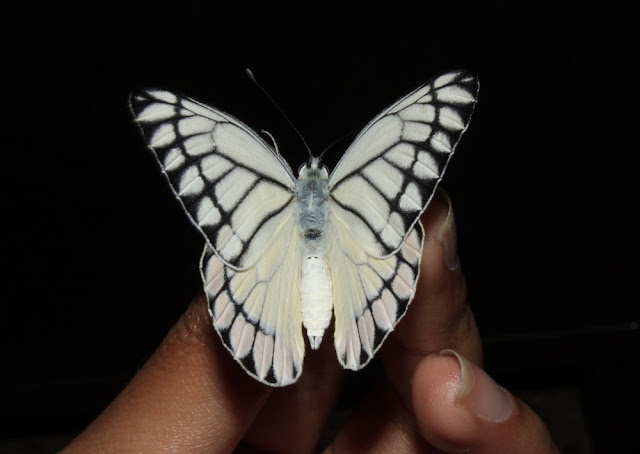It has been a long time since I wrote, and I owe this blogpost to one particular person who made me feel jealous of his wonderful writing, which prompted me to get back to the blog and give it much needed attention! Thank you, friend! :D
In Bangalore, summer is hotter every year. As I sat wondering why this phenomenon has been happening, I thought I heard a Malabar Whistling Thrush calling. "What the hell?!" I was startled. Before I could look start meaninglessly looking around, I was convinced that my mind was going crazy. That was probably because of my desperation to be in the Western Ghats. It had been a few months, and it was about time that I needed my drug! I sat down, and images of the whispy, layery Sahyadris swarmed through my head. The streams that curve and meander through the undulating green mountains, the brooks that disappear into dead ends, the small seasonal waterfalls, the Malabar Giant Squirrels, the gorgeous woodpeckers, the damselflies that I can't identify, and the butterflies that make me feel like saying "
Wow, this is what I was born to do! Lets chase!" I wanted that feeling back. The Western Ghats feeling.
Very fortunately this time, I quickly found many reasons to be there. The route was Bangalore-Mysore-Nagarhole-Kutta-Ponnampet-Gonikoppal-Madikeri-Brahmagiri-Kushalnagar-and back.
On 27th April, the four of us started off. The route was obviously boring till Nagarhole. But once we reached the Nagarhole post, I began to count the number of Spot Swordtails (Graphium nomius) that flew past. The movement of the Graphiums seemed to be in a North to South direction. The entire 30-or so kilometres worth of driving resulted in a count of about 200+ individuals. The place was also flooded with Common Emigrants (Catopsilia pomona). I thought that these must be local migrants. They might also have dispersed from another place which is not so far off, due to the lack of host plants.
A sketch of the Spot Swordtail (Graphium nomius):
As we drove past Nagarhole and into Madikeri via Kutta and Ponnampet, we stopped at several places to see the Malabar Giant Squirrels. They are such adorable creatures! One of them was sleeping on a branch very close to us, and we did not dare disturb it. Slowly, we drove, making our presence as undetectable as possible.
Madikeri was a grand feast. The plantations, the tall trees which reach out to the clouds, the turns and the blind corners on the road!
It rained very heavily the night we reached there. The sky thundered and roared as I sat and watched in awe. It was the first rainfall of the season. Due to this, there weren't many butterflies around. Nevertheless, I did find a Common Silverline (Spindasis vulcanus) and clicked it against the mountains in the background!
The graceful, elegant and high-flying Sahyadri Red Helen surprisingly came down to eye level to drink nectar from the Periwinkles.

I saw a beautiful Indian Krait disappear into the thickets for a good ten seconds while I was walking my way across a path inside a plantation. The scary thing about the plantations in Coorg - the watchdogs! I was freaked out to my bones when one of them showed me the most snarly face ever. It was as if to say "Get the hell out of this plantation or I will chew your face off!" Luckily, someone who worked at the plantation was there to hold him down and allow me to walk about without being eaten up. It was in one of these plantations that I saw a bird that I had always dreamt of. At first, I thought it was an Indian Horned Owl. But then, there were no "horns". They were small ear tufts instead. It took me a while to realize that the bird I was staring at through my fog-covered binoculars was none other than a Brown Fish Owl. It sat there motionlessly, as if it were divine. I stared on till my hunger outweighed my desire to keep staring (That took a lot of time!). It was hard to bid goodbye to the beautiful creature.
The next day, we drove upwards to Brahmagiri peak. Delightful landscapes enthralled me to no ends!
It was absolutely foggy. The visibility on the top was reduced to about 50-60 feet due to the previous night's rains.
Here, at a height of about 6000ft above sea level, I came across a courting pair of Painted Lady butterflies. (Vanessa cardui) They would hardly sit down, but I managed to click one shot before my luck ran out.
The next day, we set off to the nearby Abbey falls. It was here that I saw a very interesting bird which seemed to fly in a particular orbit. I could not identify this without getting back to base and checking the field guides. It was a Crested Goshhawk (Accipiter trivirgatus).
The way down Brahmagiri was spent driving down in the rain. I spotted a few Malabar Pied Hornbills, and heard the call of Junglefowls.
On the way back to Bangalore, we made a stop at this Tibetean settlement at Kushalnagar. The Golden Buddhist Temple is a very beautiful place with a massive Buddha statue!
After all this, it was difficult to accept that it was time to return to Bangalore. But yet, we drove back. The hailstones and the heavy rain made the journey very pleasant! The rain faded away as we reached Bangalore, and then, we braced ourselves to get entangled in the boring routine ahead. :)























































